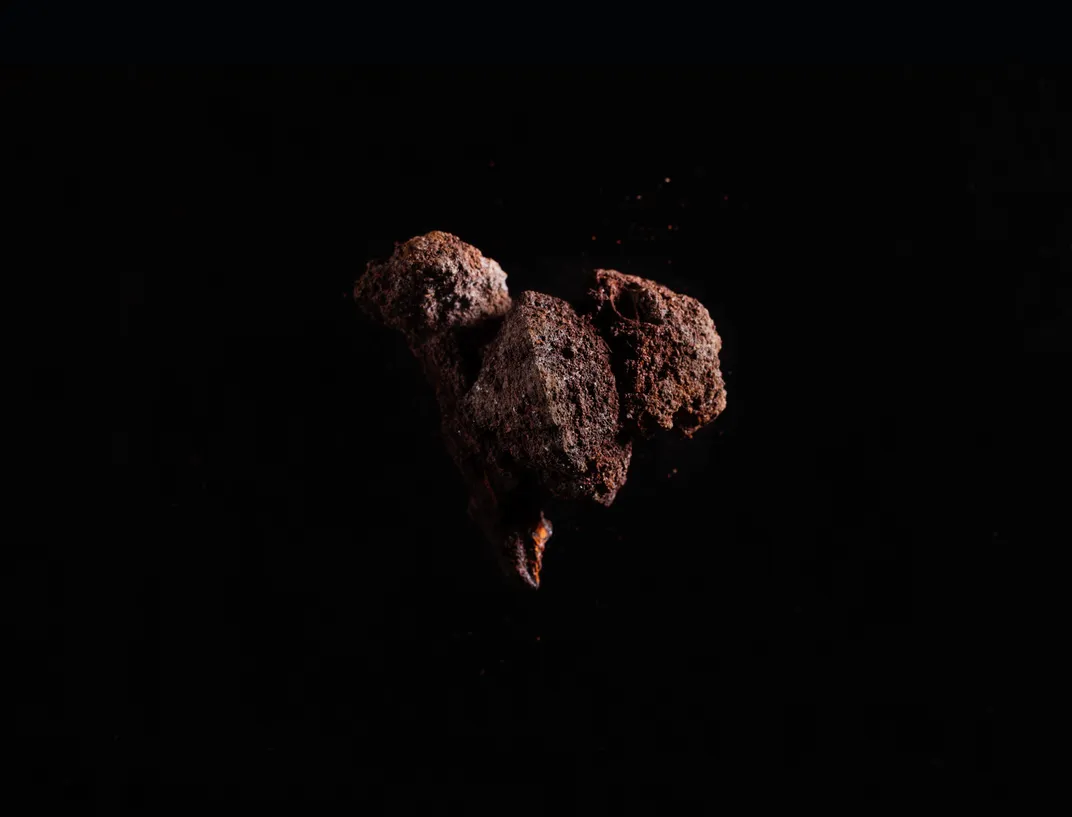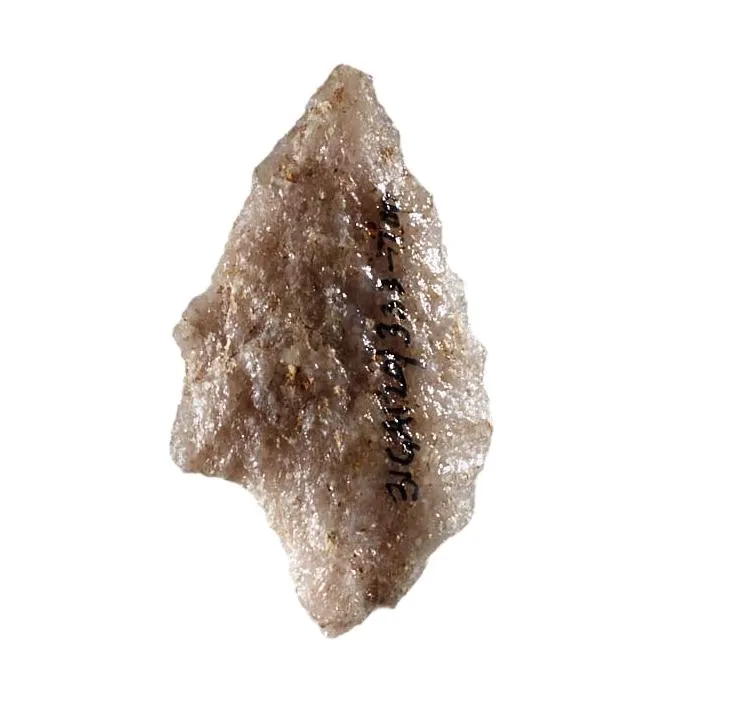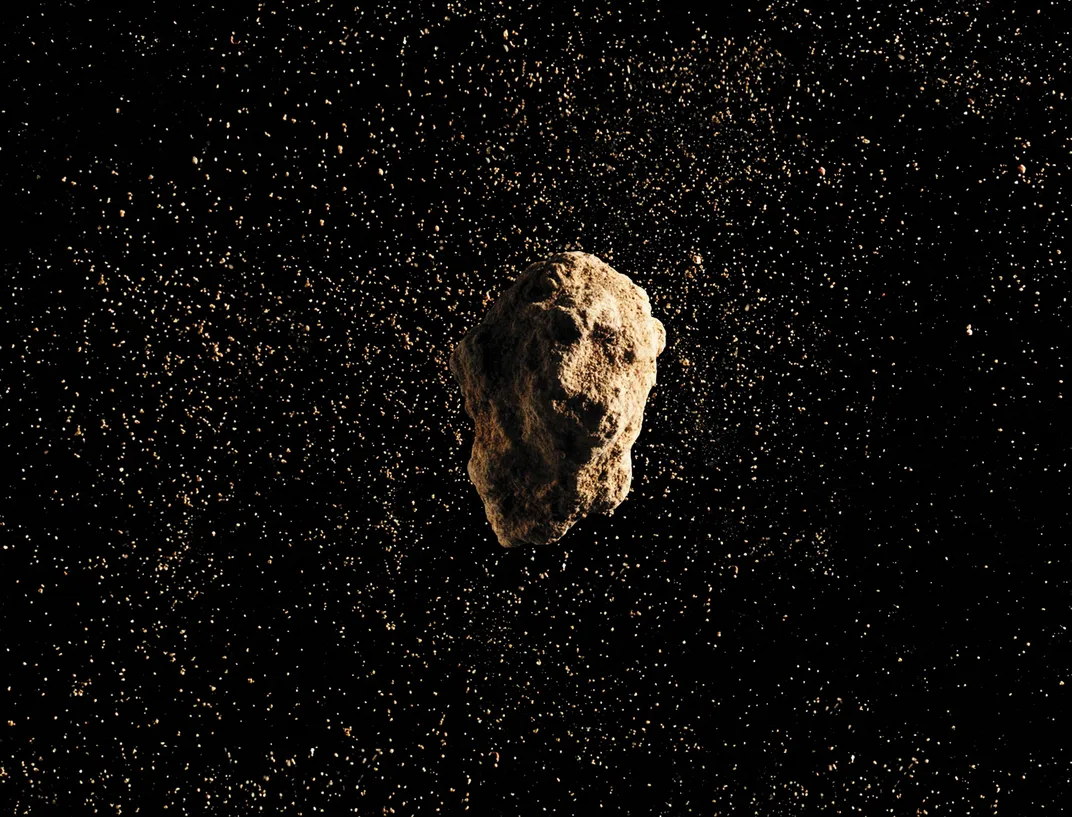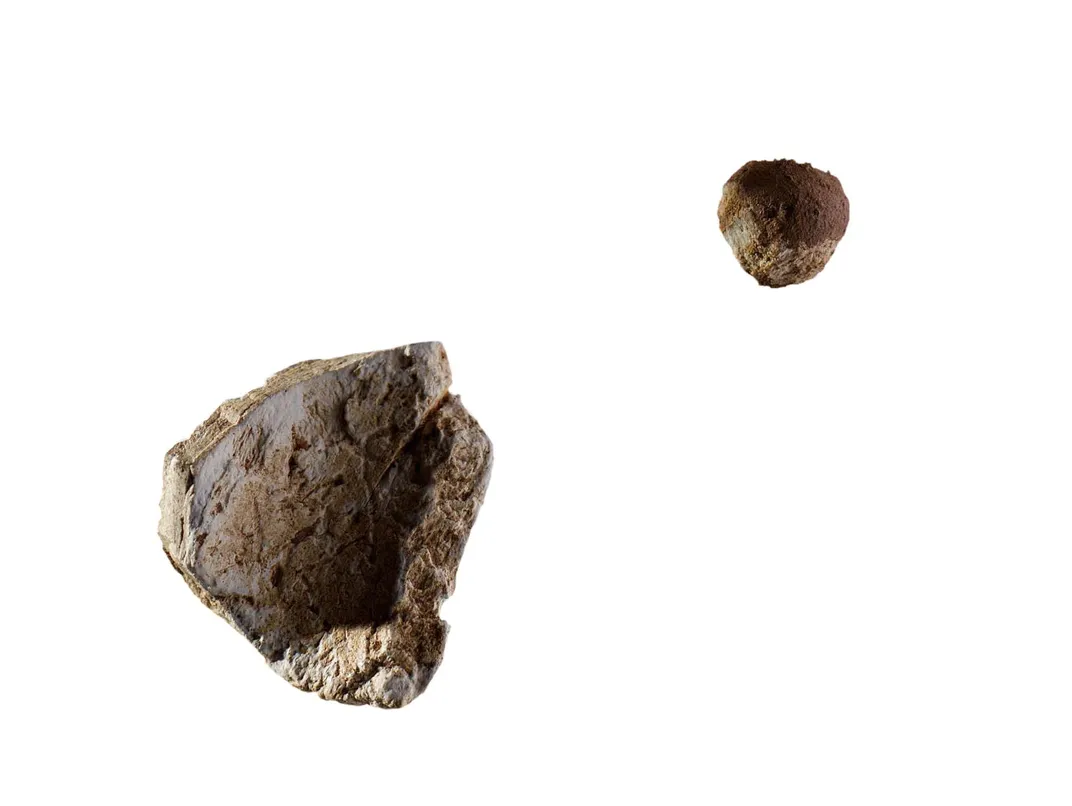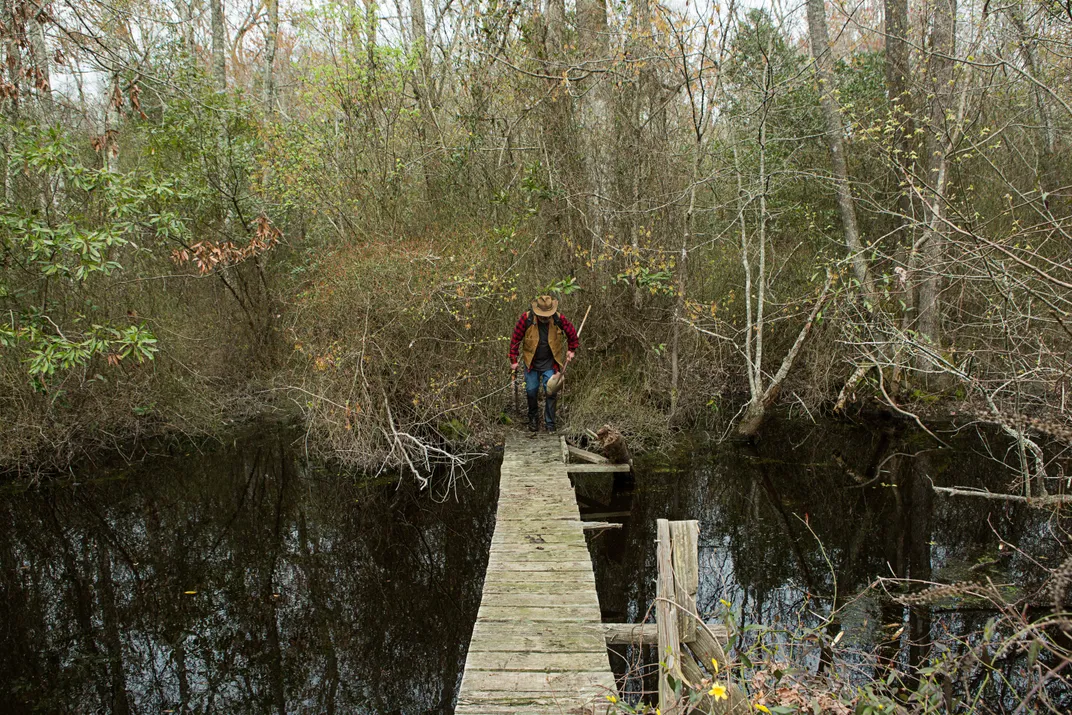Deep in the Swamps, Archaeologists Are Finding How Fugitive Slaves Kept Their Freedom
The Great Dismal Swamp was once a thriving refuge for runaways
:focal(2763x2302:2764x2303)/https://tf-cmsv2-smithsonianmag-media.s3.amazonaws.com/filer/51/ee/51ee3608-6f5a-41a9-93d5-3b7d126f6bc2/sep2016_b04_greatdismalswamp.jpg)
The worse it gets, as I wade and stumble through the Great Dismal Swamp, the better I understand its history as a place of refuge. Each ripping thorn and sucking mudhole makes it clearer. It was the dense, tangled hostility of the swamp and its enormous size that enabled hundreds, and perhaps thousands, of escaped slaves to live here in freedom.
We don’t know much about them, but thanks to the archaeologist hacking through the mire ahead of me, we know they were out here, subsisting in hidden communities, and using almost nothing from the outside world until the 19th century. The Dismal Swamp covered great tracts of southeast Virginia and northeast North Carolina, and its vegetation was far too thick for horses or canoes. In the early 1600s, Native Americans fleeing the colonial frontier took refuge here, and they were soon joined by fugitive slaves, and probably some whites escaping indentured servitude or hiding from the law. From about 1680 to the Civil War, it appears that the swamp communities were dominated by Africans and African-Americans.
Thigh deep in muddy water, wearing Levis and hiking boots rather than waterproof waders like me, Dan Sayers stops to light a cigarette. He’s a historical archaeologist and chair of the anthropology department at American University in Washington, D.C., but he looks more like an outlaw country singer. Long-haired and bearded, 43 years old, he habitually wears a battered straw cowboy hat and a pair of Waylon Jennings-style sunglasses. Sayers is a Marxist and a vegan who smokes nearly two packs a day and keeps himself revved up on Monster Energy drinks until it’s time to crack a beer.
“I was such a dumb-ass,” he says. “I was looking for hills, hummocks, high ground because that’s what I’d read in the documents: ‘Runaway slaves living on hills....’ I had never set foot in a swamp before. I wasted so much time. Finally, someone asked me if I’d been to the islands in North Carolina. Islands! That was the word I’d been missing.”
The Great Dismal Swamp, now reduced by draining and development, is managed as a federal wildlife refuge. The once-notorious panthers are gone, but bears, birds, deer and amphibians are still abundant. So are venomous snakes and biting insects. In the awful heat and humidity of summer, Sayers assures me, the swamp teems with water moccasins and rattlesnakes. The mosquitoes get so thick that they can blur the outlines of a person standing 12 feet away.
In early 2004, one of the refuge biologists strapped on his waders and brought Sayers to the place we’re going, a 20-acre island occasionally visited by hunters, but completely unknown to historians and archaeologists. Before Sayers, no archaeology had been done in the swamp’s interior, mainly because conditions were so challenging. One research party got lost so many times that it gave up.
When you’ve been toiling through the sucking ooze, with submerged roots and branches grabbing at your ankles, dry solid ground feels almost miraculous. We step onto the shore of a large, flat, sun-dappled island carpeted with fallen leaves. Walking toward its center, the underbrush disappears, and we enter a parklike clearing shaded by a few hardwoods and pines.
“I’ll never forget seeing this place for the first time,” recalls Sayers. “It was one of the greatest moments of my life. I never dreamed of finding a 20-acre island, and I knew instantly it was livable. Sure enough, you can’t put a shovel in the ground anywhere on this island without finding something.”
He has named his excavation areas—the Grotto, the Crest, North Plateau and so on—but he won’t name the island itself. In his academic papers and his 2014 book, A Desolate Place for a Defiant People, Sayers refers to it as the “nameless site.” “I don’t want to put a false name on it,” he explains. “I’m hoping to find out what the people who lived here called this place.” As he sifts the earth they trod, finding the soil footprints of their cabins and tiny fragments of their tools, weapons and white clay pipes, he feels a profound admiration for them, and this stems in part from his Marxism.
“These people performed a critique of a brutal capitalistic enslavement system, and they rejected it completely. They risked everything to live in a more just and equitable way, and they were successful for ten generations. One of them, a man named Charlie, was interviewed later in Canada. He said that all labor was communal here. That’s how it would have been in an African village.”
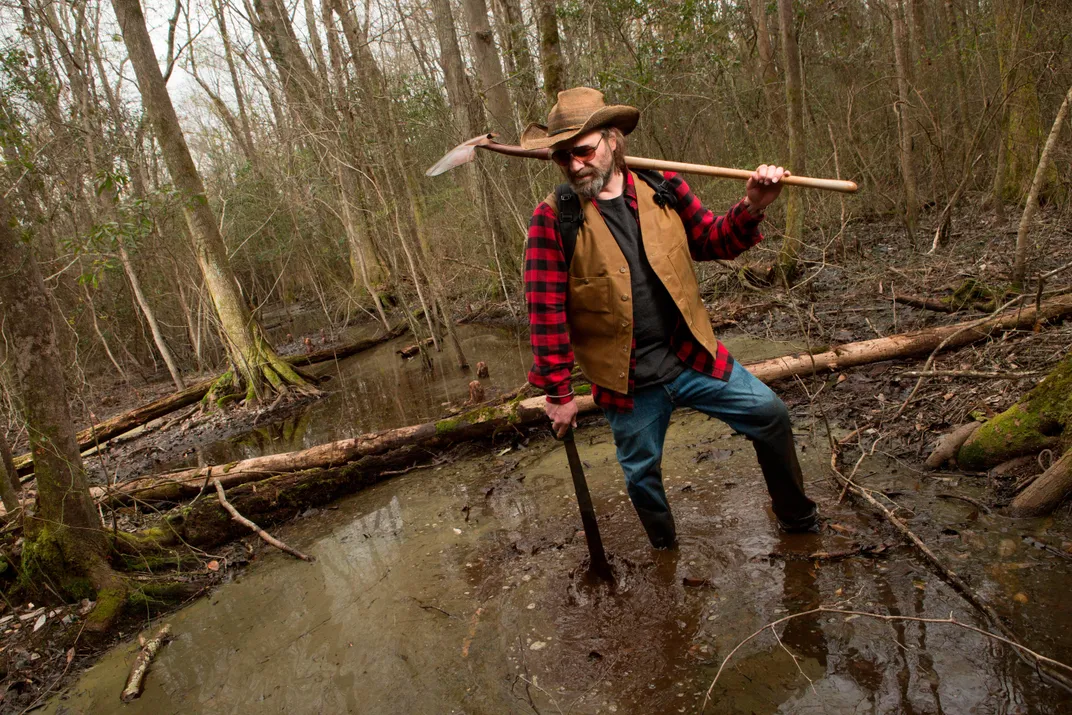
**********
Wherever Africans were enslaved in the world, there were runaways who escaped permanently and lived in free independent settlements. These people and their descendants are known as “maroons.” The term probably comes from the Spanish cimarrón, meaning feral livestock, fugitive slave or something wild and defiant.
Marronage, the process of extricating oneself from slavery, took place all over Latin America and the Caribbean, in the slave islands of the Indian Ocean, in Angola and other parts of Africa. But until recently, the idea that maroons also existed in North America has been rejected by most historians.
“In 2004, when I started talking about large, permanent maroon settlements in the Great Dismal Swamp, most scholars thought I was nuts,” says Sayers. “They thought in terms of runaways, who might hide in the woods or swamps for a while until they got caught, or who might make it to freedom on the Underground Railroad, with the help of Quakers and abolitionists.”
By downplaying American marronage, and valorizing white involvement in the Underground Railroad, historians have shown a racial bias, in Sayers’ opinion, a reluctance to acknowledge the strength of black resistance and initiative. They’ve also revealed the shortcomings of their methods: “Historians are limited to source documents. When it comes to maroons, there isn’t that much on paper. But that doesn’t mean their story should be ignored or overlooked. As archaeologists, we can read it in the ground.”
Sayers first heard about the Dismal Swamp maroons from one of his professors at the College of William and Mary in Williamsburg, Virginia. They were smoking cigarettes after class in late 2001. Sayers proposed to do his dissertation on the archaeology of 19th-century agriculture. Stifling a yawn, Prof. Marley Brown III asked him what he knew about the maroons of the Great Dismal Swamp and suggested this would make a more interesting dissertation project. “It sounded great,” says Sayers. “I had no idea what I was getting into.”
He started doing archival research on the Great Dismal Swamp. He found scattered references to maroons dating back to the early 1700s. The first accounts described runaway slaves and Native Americans raiding farms and plantations, and then disappearing back into the swamp with stolen livestock. In 1714, Alexander Spotswood, the colonial lieutenant governor of Virginia, described the Dismal Swamp as a “No-man’s-land,” to which “Loose and disorderly people daily flock.” Since Africans and African-Americans were not referred to as “people” in the records of 18th-century Virginia, this suggests that poor whites were also joining the swamp communities.
In 1728, William Byrd II led the first survey into the Great Dismal Swamp, to determine the Virginia/North Carolina boundary. He encountered a family of maroons, describing them as “mulattoes,” and was well aware that others were watching and hiding: “It is certain many Slaves Shelter themselves in this Obscure Part of the World....” Byrd, an aristocratic Virginian, loathed his time in the swamp. “Never was rum, that cordial of life, found more necessary than it was in this dirty place.”
From the 1760s until the Civil War, runaway slave ads in the Virginia and North Carolina newspapers often mentioned the Dismal Swamp as the likely destination, and there was persistent talk of permanent maroon settlements in the morass. British traveler J.F.D. Smyth, writing in 1784, gleaned this description: “Runaway negroes have resided in these places for twelve, twenty, or thirty years and upwards, subsisting themselves in the swamp upon corn, hogs, and fowls....[On higher ground] they have erected habitations, and cleared small fields around them.”
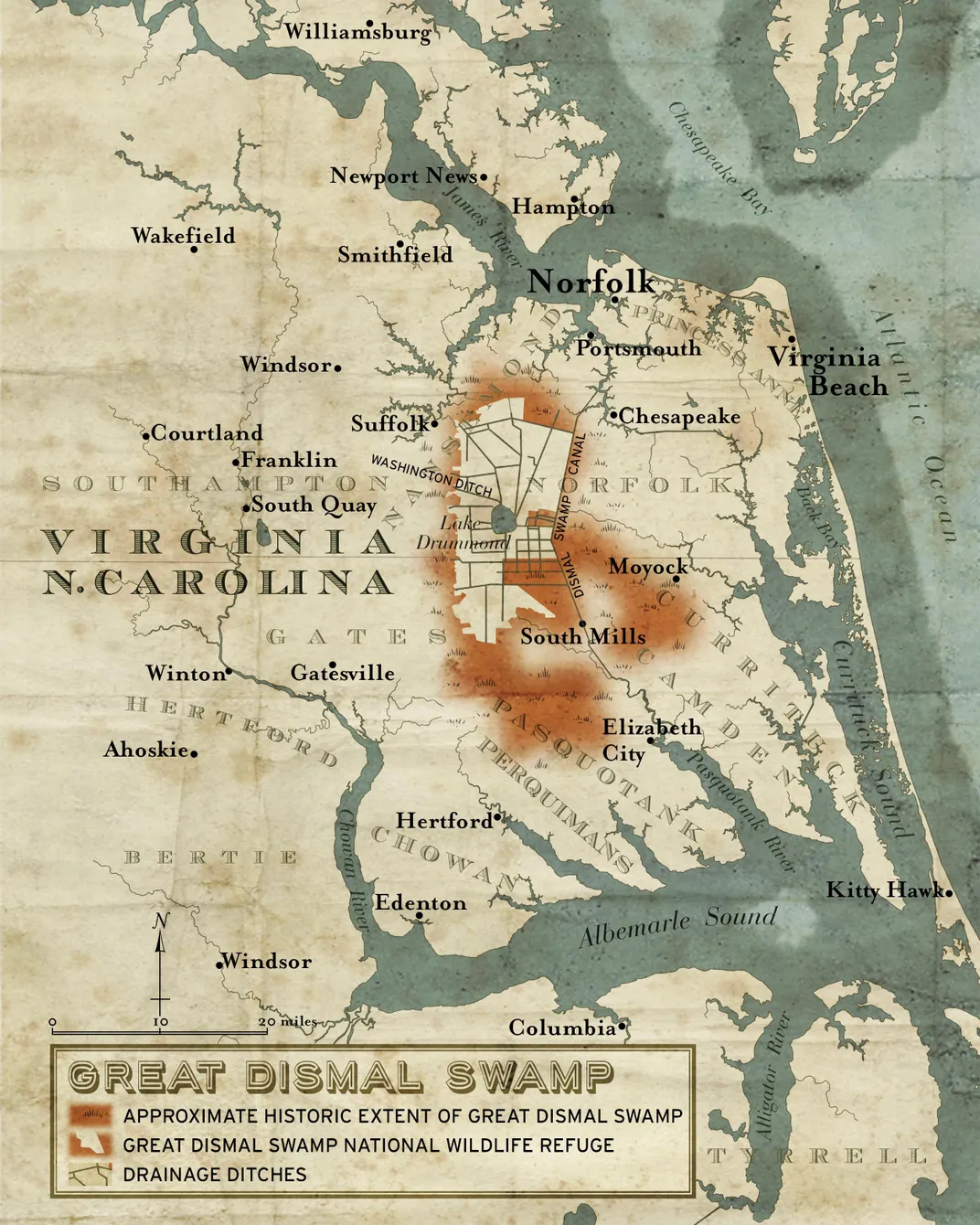
The most comprehensive work that Sayers found was a 1979 dissertation by an oddball historian named Hugo Prosper Leaming. He was a white Unitarian minister and civil rights activist who managed to get accepted into a Black Muslim temple in Chicago and wore a fez with his Unitarian robes. Leaming surveyed local and state records related to the Dismal Swamp, and scoured unpublished local histories, memoirs and novels for references to maroons. In his dissertation, later published as a book, he presents a detailed account of maroon history in the swamp, with a list of prominent chiefs and vivid descriptions of Africanized religious practices.
“His interpretations are stretchy, but I like the book, and it was useful on the history,” says Sayers. “When it came to the archaeology, I had nothing. I didn’t know where to look, or what to look for. So I decided to survey the swamp, find the high ground and dig there.”
The most useful map was a digital representation of the swamp’s vegetation. It showed clusters of tree species that typically grow on higher, drier ground. To help him get into these areas, Sayers recruited young, energetic assistants and armed them with machetes and loppers. “I remember one day in particular,” he says. “There were four of us and we went at it with everything we had, just sweating bullets. In eight hours, we made 200 feet. The brush was so thick it would have taken us a week to get there, so we gave up.”
On the edge of the swamp, where sites were more accessible, Sayers found some artifacts that clearly suggested maroons. But it wasn’t until he saw the island that he felt the rush of a big discovery. He went back to his professors with a timetable. In 12 weeks, he would identify the key sites, complete the shovel tests and perform his excavations. Then he’d be ready to write his dissertation.
“It was probably the greatest underestimation in the history of archaeology,” he says. “Instead of 12 weeks, it took three eight-month sessions. Then I spent five more summers excavating with my students in field schools.”
All the excavation sites at the nameless site are now filled in and covered over. Apart from some water catchment pits with fire-hardened floors, there’s not much he can show me. But Sayers is an expressive talker and gesticulator, and as he walks me around the island, he conjures up clusters of log cabins, some with raised floors and porches. He points to invisible fields and gardens in the middle distance, children playing, people fishing, small groups off hunting. Charlie, the ex-maroon interviewed in Canada, described people making furniture and musical instruments.
“There were hardships and deprivations, for sure,” he says. “But no overseer was going to whip them here. No one was going to work them in a cotton field from sunup to sundown, or sell their spouses and children. They were free. They had emancipated themselves.”
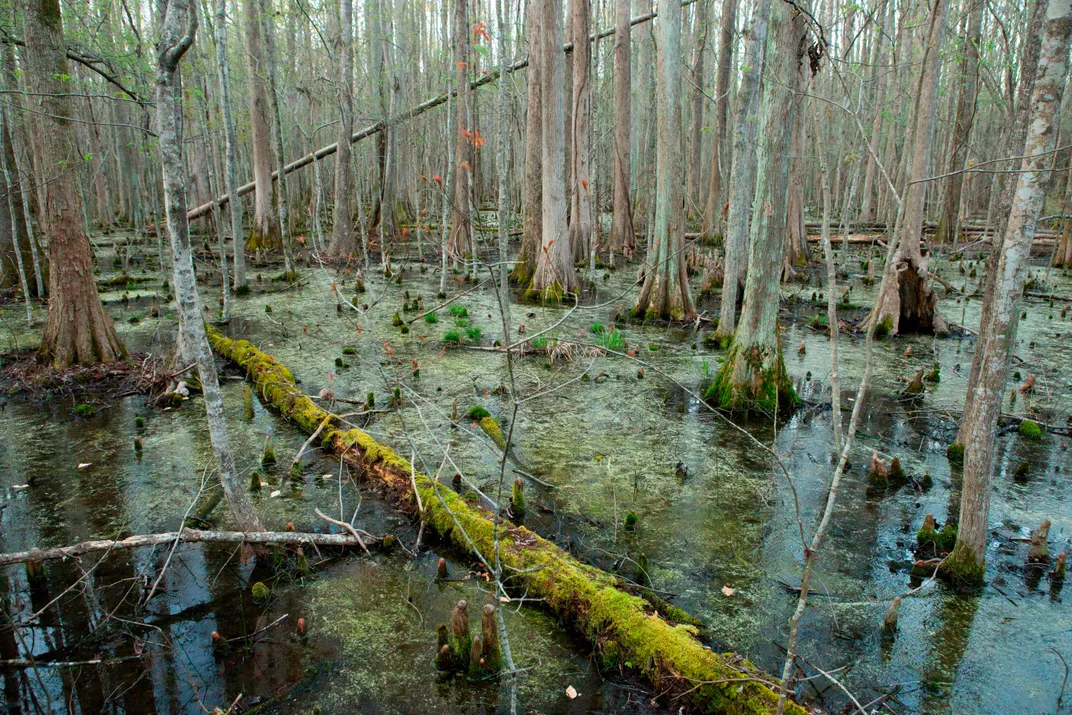
**********
On the outside wall of Dan Sayers’ office at American University is a large photograph of Karl Marx, and a flier for Great Dismal Black IPA beer. Inside, the office has a comfortable, masculine, lived-in feel. There’s an old pith helmet hanging on the wall, and a Jaws poster, and the front page of a newspaper announcing Obama’s election. In the bookshelves are the entire works of Karl Marx.
I ask him how his Marxism influences his archaeology. “I think capitalism is wrong, in terms of a social ideal, and we need to change it,” he says. “Archaeology is my activism. Rather than go to the Washington Mall and hold up a protest sign, I choose to dig in the Great Dismal Swamp. By bringing a resistance story to light, you hope it gets into people’s heads.”
When ideological passion drives research, in archaeology or anything else, it can generate tremendous energy and important breakthroughs. It can also lead to the glossing over of inconvenient data, and biased results. Sayers has concluded that there were large, permanent, defiant “resistance communities” of maroons in the Great Dismal Swamp. Is there a danger that he’s over-interpreted the evidence?
“Historical archaeology does require interpretation,” he says. “But I always imagine what my worst critic is going to say, or want as evidence, and I’ve done a decent enough job to convince my academic peers on this. There’s a few who don’t buy it. The show-me-the-money historians don’t see much money.”
He takes me down the hall to his laboratory, where soil samples are stacked in plastic bags on high shelving units and hundreds of artifacts are bagged, numbered and stored in metal cabinets. I ask to see the most important and exciting finds. “In one sense, this has been the most frustrating archaeology project imaginable,” he says. “We haven’t found much, and everything is small. On the other hand, it’s fascinating: These soils are completely undisturbed. You’re scratching the surface of an undiscovered world.”
In order to date these soils, and the traces of human occupation left in them, Sayers used a combination of techniques. One was the law of superposition: Layers of undisturbed soil get older as you dig deeper. Also, artifacts found in them, arrowheads, pottery and manufactured items like nails, can be dated through the collective knowledge of historical archaeologists, based on the objects’ style and attributes. The third technique was optically stimulated luminescence, or OSL.
“We collected soil samples without exposing them to sunlight and sent them to a lab,” he explains. “They can measure when these grains of sand last saw sunlight. Normally, historical archaeological projects don’t need to use OSL because there are documents and mass-produced artifacts. It’s a testament to how unique these communities were in avoiding the outside world.”
Before 1660, most people at the nameless site were Native Americans. The first maroons were there within a few years of the arrival of African slaves in nearby Jamestown in 1619. After 1680, Native American materials become scarce; what he identifies as maroon artifacts begin to dominate.
Sayers pulls out a stone arrowhead about an inch long, one side chipped away to form a tiny curved knife or scraper. “In the interior of the swamp, there was only one source of stone,” he says. “Tools left behind by indigenous Americans. Maroons would find them, modify them, and keep using them until they were worn down into tiny nubs.”
Nothing was more exciting than finding the footprints of seven cabins at the nameless site, in the 1660-1860 range. “We know from documents that maroons were living in the swamp then. There’s no record of anyone else living there. It is certainly not the type of place that you would make a choice to live in, unless you needed to hide.”
He pulls out a disk of plain, earth-colored Native American pottery, the size of a large cookie. “Maroons would find ceramics like this, and jam them down into the post holes of their cabins, to shore them up. This is probably the largest item we’ve found.” Then he shows me a tiny rusted copper bead, perhaps worn as jewelry, and another bead fused to a nail. The artifacts keep getting smaller: flakes of pipe clay, gunflint particles from the early 19th century, when the outside world was pushing into the swamp.
“Everything we’ve found would fit into a single shoe box,” he says. “And it makes sense. They were using organic materials from the swamp. Except for the big stuff like cabins, it decomposes without leaving a trace.”
Seven miles away from American University, at the new National Museum of African American History and Culture, an exhibit about the maroons of the Great Dismal Swamp is scheduled to go on view. For the curator Nancy Bercaw, it presented an unusual challenge. “The ethos here is that objects should speak for themselves,” she says, talking over coffee in her office. “Dan Sayers generously gave us ten objects. They are reworked pebbles, shims for post holes, tiny fragments of stone from an unnamed island. Some of them look like grains of sand.”
Artifact 1 is a white clay tobacco-pipe fragment, 12 millimeters long. There is a small chunk of burnt clay, a five-millimeter piece of flattened lead shot, a quartz flake, a British gunflint chip (circa 1790), a shard of glass, a nail head with a partial stem.
They are not the sort of objects, in other words, that catch the eye or speak for themselves. Her solution was to mount some of them in jewel cases like priceless treasures.
The exhibit is in the 17,000-square-foot Slavery and Freedom gallery, in a section about free communities of color. “Traditionally, we’ve studied the institution of slavery, not enslavement as it was lived,” she says. “Once you start looking at our history through an African-American lens, it really changes the focus. Maroons become much more significant.”
The largest community of American maroons was in the Great Dismal Swamp, but there were others in the swamps outside New Orleans, in Alabama and elsewhere in the Carolinas, and in Florida. All these sites are being investigated by archaeologists.
“The other maroon societies had more fluidity,” says Bercaw. “People would slip off down the waterways, but usually maintain some contact. The Dismal Swamp maroons found a way to remove themselves completely from the United States, in the recesses of its geography.”
**********
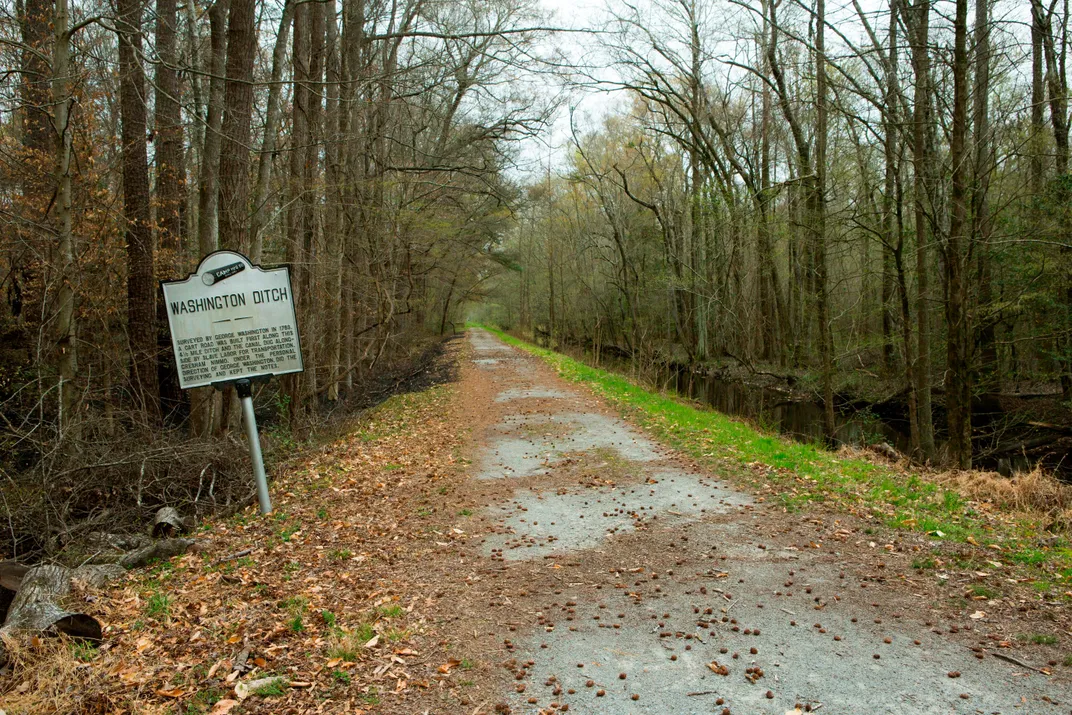
On a cool cloudy morning in the Great Dismal Swamp, Sayers parks his vehicle by a long straight ditch full of black water. He sips his Monster, and sucks fire into a cigarette. The ditch arrows through the gloomy swamp to a vanishing point in the far distance.
“This is Washington Ditch, a somewhat unique monument to brutality and entrepreneurship,” he says. George Washington was the first to see economic opportunity in the vast coastal swamp south of Norfolk, Virginia. In 1763, he formed a company with fellow investors to drain the swamp, exploit its timber resources and dig canals for transportation. This is the first canal, completed in the late 1760s, and excavated by slaves.
“Imagine it,” says Sayers. “Digging, chopping, bailing mud, working in chest-high water. One hundred degrees in summer, full of water moccasins, ungodly mosquitoes. Freezing cold in winter. Beatings, whippings. Deaths were fairly common.”
The canal now known as Washington Ditch was the first significant encroachment into the Great Dismal Swamp. More canals were dug. Timber companies cut thousands of acres of Atlantic white cedar, known locally as juniper, and turned it into barrel staves, ship masts and house shingles.
It became more dangerous for maroons because the canals allowed slave-catchers to get into the swamp. But there were also new economic opportunities. Maroons were able to cut shingles for lumber companies that turned a blind eye. Frederick Law Olmsted, who traveled in the South as a journalist before he took up landscape architecture, writing about the maroons in 1856, observed that “poorer white men, owning small tracts of the swamps, will sometimes employ them,” and also that maroons were stealing from farms, plantations and unwary travelers.
Olmsted asked if locals ever shot the maroons. “Oh yes,” came the reply. “But some on ’em would rather be shot than be took, sir.” It’s clear that there were two different ways of marooning in the swamp. Those living near the edge of the swamp, or near the canals, had far more interaction with the outside world. In the remote interior, at the nameless site and other islands, there were still maroons who lived in isolation, fishing, farming and trapping feral hogs in the deep swamp muck. We know this from Dan Sayers’ excavations and from Charlie the former maroon. He described whole families that had never seen a white man and would be scared to death to see one.
The white residents of Norfolk and other communities near the swamp were terrified of being attacked by the swamp’s maroons. Instead, they got Nat Turner’s insurrection of 1831—a rebellion of slaves and free blacks in which more than 50 whites were killed and then at least 200 blacks killed in reprisal. Turner was planning to hide in the Dismal Swamp with his followers, recruit the maroons and more slaves, and then emerge to overthrow white rule. But his rebellion was suppressed after two days, and Turner, after two months in hiding, was captured and hanged.
What became of the Dismal Swamp maroons? Olmsted thought that very few were left by the 1850s, but he stayed near the canals and didn’t venture into the interior. Sayers has evidence of a thriving community at the nameless site all the way up to the Civil War. “That’s when they came out,” he says. “We’ve found almost nothing after the Civil War. They probably worked themselves back into society as free people.”
Early in his research, he started interviewing African-Americans in communities near the swamp, hoping to hear family stories about maroons. But he abandoned the side project. “There’s still so much archaeology work to do,” he says. “We’ve excavated only 1 percent of one island.”
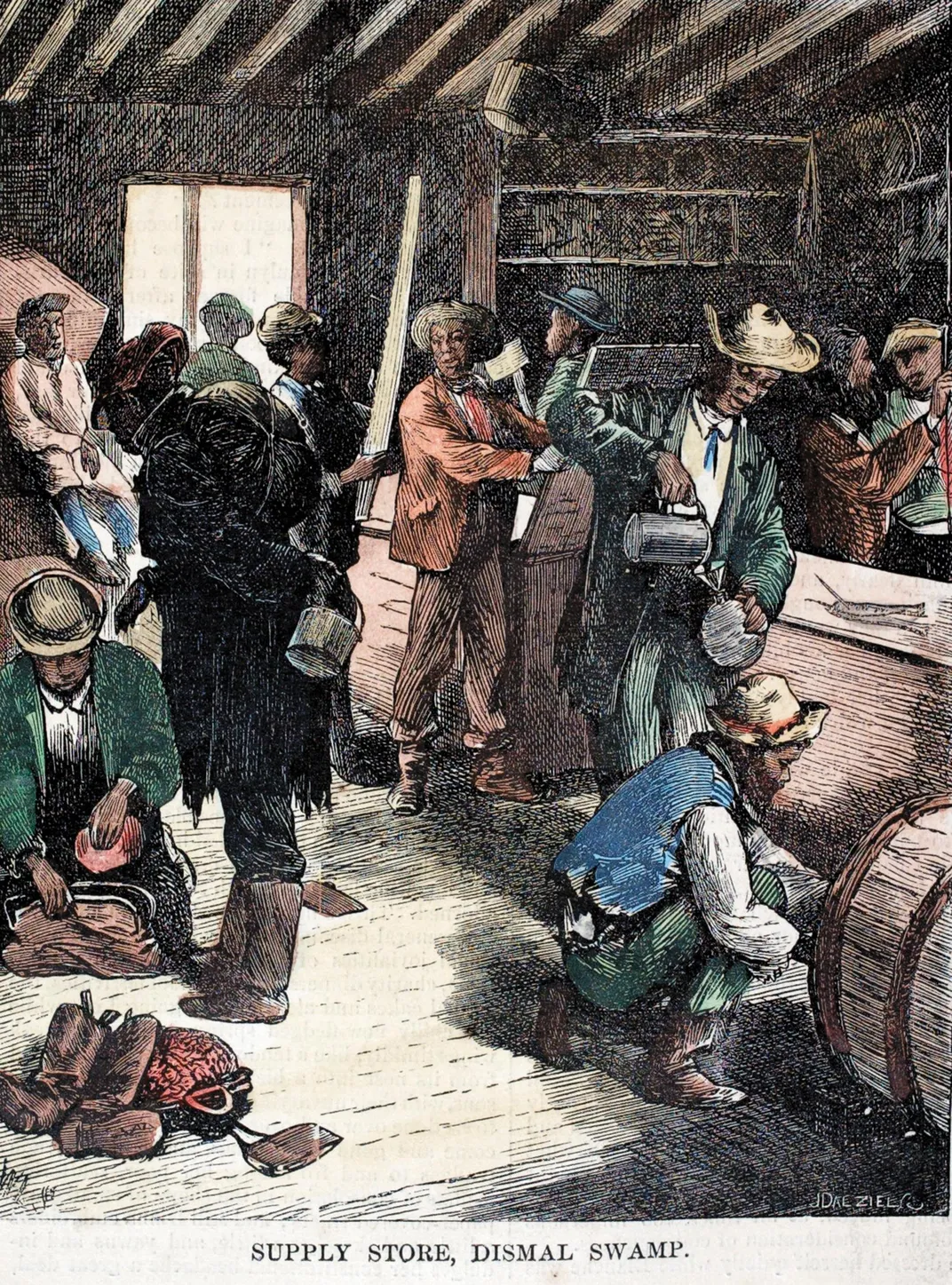
**********
He’s out of Monsters and low on cigarettes. It’s time to leave the Great Dismal Swamp and find the nearest convenience store. On a raised gravel road, we pass through a charred expanse of forest, torched by a lightning fire. We skirt the shores of Lake Drummond, the perfect blue lake at the center of the swamp, and drive on through waterlogged cypress trees and stretches where the road is walled in on both sides by thorny brush.“I got very comfortable being in the swamp,” he says. “Bears would watch me excavating. I ran into huge water moccasins and rattlesnakes as thick around as my thigh. But nothing worse happened than scrapes, bug bites and losing equipment in the muck.” Once he was wading to the nameless site with a group of students. A young woman stepped into an underwater hole and disappeared. But she surfaced a moment later, with no damage done. On many occasions, students and other visitors became so entangled in thorn patches that they had to be cut loose. “Nothing happens quickly or easily,” he says. “The swamp is a trickster and summertime is really tough. But I love it. The thunderstorms are really something. The sound of the frogs and the insects and the birds, just as the maroons heard it. I love what the swamp has done for me, and I love what it did for them.”
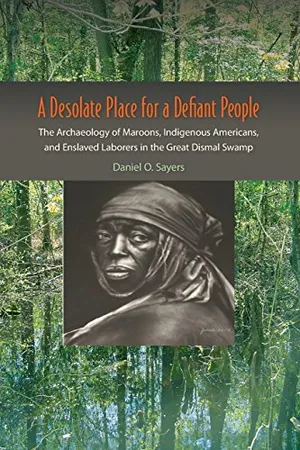
A Desolate Place for a Defiant People
